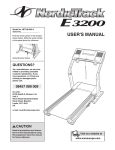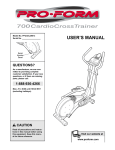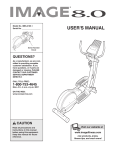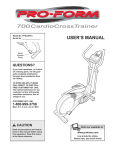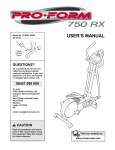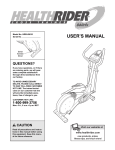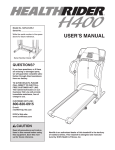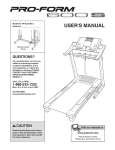Download USER`S MANUAL - Icon Heath & Fitness
Transcript
Model No. HREVEL6985.0 Serial No. Serial Number Decal QUESTIONS? As a manufacturer, we are committed to providing complete customer satisfaction. If you have questions, or if there are missing or damaged parts, please call: 08457 089 009 Or write: ICON Health & Fitness, Ltd. Customer Service Department Unit 4 Revie Road Industrial Estate Revie Road Beeston Leeds, LS118JG UK email: [email protected] CAUTION Read all precautions and instructions in this manual before using this equipment. Keep this manual for future reference. USER’S MANUAL TABLE OF CONTENTS IMPORTANT PRECAUTIONS . . . . . . . . . . . . . . . . . . . . . . . . . . . . . . . . . . . . . . . . . . . . . . . . . . . . . . . . . . . . . . . . .3 BEFORE YOU BEGIN . . . . . . . . . . . . . . . . . . . . . . . . . . . . . . . . . . . . . . . . . . . . . . . . . . . . . . . . . . . . . . . . . . . . . . .4 ASSEMBLY . . . . . . . . . . . . . . . . . . . . . . . . . . . . . . . . . . . . . . . . . . . . . . . . . . . . . . . . . . . . . . . . . . . . . . . . . . . . . . .5 HOW TO USE THE CHEST PULSE SENSOR . . . . . . . . . . . . . . . . . . . . . . . . . . . . . . . . . . . . . . . . . . . . . . . . . . .10 HOW TO OPERATE THE ELLIPTICAL CROSSTRAINER . . . . . . . . . . . . . . . . . . . . . . . . . . . . . . . . . . . . . . . . . .12 MAINTENANCE AND TROUBLESHOOTING . . . . . . . . . . . . . . . . . . . . . . . . . . . . . . . . . . . . . . . . . . . . . . . . . . . .23 CONDITIONING GUIDELINES . . . . . . . . . . . . . . . . . . . . . . . . . . . . . . . . . . . . . . . . . . . . . . . . . . . . . . . . . . . . . . .24 PART LIST . . . . . . . . . . . . . . . . . . . . . . . . . . . . . . . . . . . . . . . . . . . . . . . . . . . . . . . . . . . . . . . . . . . . . . . . . . . . . . .26 EXPLODED DRAWING . . . . . . . . . . . . . . . . . . . . . . . . . . . . . . . . . . . . . . . . . . . . . . . . . . . . . . . . . . . . . . . . . . . . .27 ORDERING REPLACEMENT PARTS . . . . . . . . . . . . . . . . . . . . . . . . . . . . . . . . . . . . . . . . . . . . . . . . . .Back Cover HealthRider is a registered trademark of ICON IP, Inc. 2 IMPORTANT PRECAUTIONS WARNING: To reduce the risk of serious injury, read the following important precautions before using the elliptical crosstrainer. 1. Read all instructions in this manual and all warnings on the elliptical crosstrainer before using the elliptical crosstrainer. 9. Hold the handlebars whilst mounting, dismounting, or using the elliptical crosstrainer. 10. The pulse sensors are not medical devices. Various factors may affect the accuracy of heart rate readings. The pulse sensors are intended only as exercise aids in determining heart rate trends in general. 2. It is the responsibility of the owner to ensure that all users of the elliptical crosstrainer are adequately informed of all precautions. 3. The elliptical crosstrainer is intended for home use only. Do not use the elliptical crosstrainer in a commercial, rental, or institutional setting. 11. Keep your back straight whilst using the elliptical crosstrainer; do not arch your back. 4. Keep the elliptical crosstrainer indoors, away from moisture and dust. Place the elliptical crosstrainer on a level surface, with a mat beneath it to protect the floor or carpet. Make sure that there is enough clearance around the elliptical crosstrainer to mount, dismount, and use it. 12. If you feel pain or dizziness at any time whilst exercising, stop immediately and cool down. 13. When you stop exercising, allow the pedals to slowly come to a complete stop. The elliptical crosstrainer does not have a free wheel; the pedals will continue to move until the flywheel stops. 5. Inspect and properly tighten all parts regularly. Replace any worn parts immediately. 14. Always unplug the power cord immediately after use and before cleaning the elliptical crosstrainer. 6. Keep children under 12 and pets away from the elliptical crosstrainer at all times. 7. The elliptical crosstrainer should not be used by persons weighing more than 115 kg (250 lbs.). 15. The warning decal shown on page 4 has been placed on the elliptical crosstrainer. If the decal is missing or illegible, call the telephone number on the front cover of this manual and order a free replacement decal. Apply the decal in the location shown. 8. Wear appropriate exercise clothes whilst using the elliptical crosstrainer. Always wear athletic shoes for foot protection whilst exercising. WARNING: Before beginning this or any exercise program, consult your physician. This is especially important for persons over the age of 35 or persons with pre-existing health problems. Read all instructions before using. ICON assumes no responsibility for personal injury or property damage sustained by or through the use of this product. 3 BEFORE YOU BEGIN you use the elliptical crosstrainer. If you have questions after reading this manual, please see the front cover of this manual. To help us assist you, please note the product model number and serial number before contacting us. The model number is HREVEL6985.0. The serial number can be found on a decal attached to the elliptical crosstrainer (see the front cover of this manual for the location of the decal). Congratulations for selecting the new HealthRider® CROSS TRAINER 1050T. The HealthRider CROSS TRAINER 1050T is an incredibly smooth exerciser that moves your feet in a natural elliptical path, minimising the impact on your knees and ankles. And the unique CROSS TRAINER 1050T features adjustable resistance and a state-of-the-art console to help you get the most from your exercise. Welcome to a whole new world of natural, elliptical-motion exercise from HealthRider. Before reading further, please familiarise yourself with the parts that are labelled in the drawing below. For your benefit, read this manual carefully before CD Holder Handlebar Handgrip Pulse Sensor Fan Console CD Player FRONT Water Bottle Holder* Pedal Pedal Spring Wheel BACK Levelling Foot Pedal Disk LEFT SIDE *No water bottle is included 4 ASSEMBLY Assembly requires two persons. Place all parts of the elliptical crosstrainer in a cleared area and remove the packing materials. Do not dispose of the packing materials until assembly is completed. Assembly requires the , adjustable spanner , included hex keys and your own phillips screwdriver and rubber mallet . As you assemble the elliptical crosstrainer, use the drawings below to identify the small parts needed for assembly. The number in parentheses below each drawing is the key number of the part, from the PART LIST on page 26. The number following the parentheses is the quantity needed for assembly. Note: Some parts may have been pre-assembled. If a part is not in the parts bag, check to see if it has been pre-assembled. Wave Washer (94)–2 M10 Split Washer (70)–4 M8 Nylon Locknut (46)–4 M6 x 16mm Tapered Button Screw (71)–8 M8.5 Washer (53)–2 M10 Washer (38)–6 M4 x 12mm Tap Screw (84)–2 M10 Nylon Locknut (29)–6 Frame Spacer (83)–2 M4 x 16mm Screw (66)–4 Adjustment Bolt (20)–2 M8 x 25mm Patch Screw (22)–2 M10 x 78mm Button Bolt (27)–2 M8 x 45mm Button Bolt (50)–4 M10 x 88mm Button Bolt (63)–2 M10 x 112mm Carriage Bolt (34)–4 5 1. Identify the Front Stabiliser (3), which has Wheels (32) attached to it. Whilst another person lifts the front of the Frame (1), attach the Front Stabiliser to the Frame with two M10 x 112mm Carriage Bolts (34) and two M10 Nylon Locknuts (29). Make sure that the Front Stabiliser is turned so the Wheels are not touching the floor. 2. Whilst another person lifts the back of the Frame (1), attach the Rear Stabiliser (4) to the Frame with two M10 x 112mm Carriage Bolts (34) and two M10 Nylon Locknuts (29). 1 32 34 32 3 1 2 29 29 4 29 1 3. Whilst another person holds the Upright (2) in the position shown, connect the Upper Wire Harness (86) to the Lower Wire Harness (87). Next, carefully pull the upper end of the Upper Wire Harness to remove any slack. Whilst holding the upper end of the Upper Wire Harness, insert the Upright into the Frame (1). Be careful to avoid pinching the Wire Harnesses. 34 3 Make sure the Wire Harnesses (86, 87) do not get pinched and damaged during this step. Slide an M10 Split Washer (70) and a Frame Spacer (83) onto each of the two M10 x 88mm Button Bolts (63). Make sure that the Frame Spacers are oriented so the curved ends are facing away from the Split Washers. Next, insert the Button Bolts into the Frame (1), and finger tighten the Button Bolts into the Upright (2). Do not tighten the Button Bolts yet. 2 63 70 83 70 6 83 86 87 1 4. Attach the Left Inner Handlebar (100) to the Upright (2) with four M6 x 16mm Tapered Button Screws (71). Do not tighten the Tapered Button Screws yet. 4 Attach the Right Inner Handlebar (101) to the Upright (2) in the same way. 101 71 100 2 71 5. Attach the CD Holder (81) to the Console (5) with two M4 x 12mm Tap Screws (84) as shown. 5 5 81 84 6. See step 7. Remove the three indicated M4 x 16mm Screws (66) and the Left Inner Handlebar Cover (102) from the Console (5). Remove the Right Inner Handlebar Cover (103) in the same way. 6 5 Whilst another person holds the Console (5) in the position shown, connect the wire harnesses on the Console to the Upper Wire Harness (86) and the Pulse Extension Wire (104). Insert the excess wire harness down into the Upright (2). Attach the Console (5) to the Upright (2) with four M4 x 16mm Screws (66). Be careful to avoid pinching the wire harnesses. 7 86 66 2 104 Console Wires 7. Attach the Left Handlebar Cover (102) to the Console (5) with three M4 x 16mm Screws (66). Attach the Right Handlebar Cover (103) in the same way. 7 5 See step 4. Tighten the eight M6 x 16mm Tapered Screws (71). 103 66 8. Identify the Left Handlebar (9), which is marked with a sticker. Insert the Left Handlebar into one of the Handlebar Legs (79); make sure that the Handlebar Leg is turned so the hexagonal holes are on the indicated side. Attach the Left Handlebar with two M8 x 45mm Button Bolts (50) and two M8 Nylon Locknuts (46). Make sure that the Nylon Locknuts are inside of the hexagonal holes. Do not tighten the Button Bolts yet. Apply a generous amount of the included grease to the Pivot Axle (92) and to the two M8.5 Washers (53). Next, insert the Pivot Axle into the Upright (2) and centre it. Reapply grease to both ends of the Pivot Axle. Slide a Handlebar Spacer (25) onto the short tube on the Left Handlebar (9), and rotate the Handlebar Spacer so the small arrow is pointing toward the floor. Next, slide the Left Handlebar onto the left end of the Pivot Axle (92). Finger tighten an M8 x 25mm Patch Screw (22) with an M8.5 Washer (53) and a Wave Washer (94) into the end of the Pivot Axle. Then, press the small tabs on a Handlebar Cap (23) into the Handlebar Spacer. Assemble the Right Handlebar (not shown) and the other Handlebar Leg (not shown) in the same way. Tighten both M8 x 25mm Patch Screws (22) at the same time. Make sure that the Wave Washers (94) are on the ends of the Pivot Axle (92). 8 102 2 8 9 22 23 50 Grease 53 94 Tube Arrow 92 25 46 Hexagonal Holes 79 2 9. Hold the lower end of the left Handlebar Leg (79) inside of the left Front Spring Bracket (17). Apply a generous amount of grease to an M10 x 78mm Button Bolt (27). Attach the left Handlebar Leg to the left Front Spring Bracket with the Button Bolt, two M10 Washers (38), and an M10 Nylon Locknut (29). Do not overtighten the Nylon Locknut; the left Handlebar Leg must pivot freely. 9 79 27 Attach the right Handlebar Leg (79) to the right Front Spring Bracket (17) in the same way. 10. Identify the Left Pedal (13). Attach the Left Pedal to the left Pedal Spring (14) with an Adjustment Bolt (20), an M10 Washer (38), an M10 Split Washer (70), and an Adjustment Knob (15) as shown. Note: The Left Pedal can be attached in any of five positions (see HOW TO ADJUST THE PEDALS on page 12). 38 10 17 17 20 13 Attach the Right Pedal (not shown) in the same way. Make sure that both Pedals are in the same position. 11. Plug one end of the Power Cord (74) into the jack at the rear of the elliptical crosstrainer. Plug the other end of the Power Cord into an appropriate outlet that is properly installed in accordance with all local codes and ordinances. 29 38 Grease See step 8. Tighten the M8 x 45mm Button Bolts (50) in the Handlebar Legs (79). See step 3. Tighten the two M10 x 88mm Button Bolts (63). 79 14 38 70 15 11 Jack 74 Note: The Console (5) can be operated with batteries instead of the Power Cord (74) if desired. To install batteries, follow the instructions below. See the inset drawing. Press the indicated tab on the battery drawer and open the battery drawer. Press four 1.5V “D” batteries into the battery clips; make sure that the batteries are oriented as shown by the markings inside of the battery clips. Then, close the battery drawer. Note: Alkaline batteries are recommended. 5 Battery Drawer Batteries Tab 12. Make sure that all parts of the elliptical crosstrainer are properly tightened. Note: Some extra hardware may be left over after assembly is completed. To protect the floor or carpet from damage, place a mat under the elliptical crosstrainer. 9 HOW TO USE THE CHEST PULSE SENSOR HOW TO PUT ON THE CHEST PULSE SENSOR CHEST PULSE SENSOR TROUBLESHOOTING If the chest pulse sensor does not function properly, or if the displayed heart rate is excessively high or low, try the troubleshooting steps below. The chest pulse sensor consists of two components: the chest strap and the sensor unit. Follow the steps below to put on the chest pulse sensor. • Make sure that you are wearing the chest pulse sensor as described at the left. If the chest pulse sensor does not function when positioned as described, move it slightly lower or higher on your chest. Chest Strap • Each time you use the chest pulse sensor, use saline solution such as saliva or contact lens solution to wet the two electrode areas on the sensor unit (see the drawing below). If heart rate readings do not appear until you begin perspiring, re-wet the electrode areas. Tab Sensor Unit 1 2 3 Buckle Sensor Unit • Make sure that you are within arm’s length of the console. For the console to display heart rate readings, the user must be within arm’s length of the console. See the inset drawing above. Insert the tab on one end of the chest strap through the hole in one end of the sensor unit. Press the end of the sensor unit under the buckle on the chest strap. • The chest pulse sensor is designed to work with people who have normal heart rhythms. Heart rate reading problems may be caused by medical conditions such as premature ventricular contractions (pvcs), tachycardia bursts, and arrhythmia. Wrap the chest pulse sensor around Logo your chest. Attach the free end of the chest strap to the sensor unit as described above. Adjust the length of the chest strap, if necessary. The chest pulse sensor should be under your clothes, against your skin, and as high under the pectoral muscles or breasts as is comfortable. Make sure that the logo is right-side-up and facing forward. • The operation of the chest pulse sensor can be affected by magnetic interference caused by high power lines or other sources. If it is suspected that magnetic interference may be causing a problem, try relocating your exercise equipment. • If the chest pulse sensor still does not function properly, test the chest pulse sensor in the following way: Hold the chest pulse sensor Electrode Areas and place your thumbs over the electrode areas as shown. Next, hold the chest pulse sensor near the console. Whilst holding one thumb stationary, begin tapping the other thumb against the electrode area at a rate of about one tap per second. Check the heart rate reading on the console. Pull the sensor unit Electrode Areas away from your body a few inches and locate the two electrode areas on the inner side. Using a saline solution such as saliva or contact lens solution, wet both electrode areas. Return the sensor unit to a position against your chest. 10 • If the chest pulse sensor does not function properly after you have followed all of the above instructions, the battery should be replaced in the following way: CHEST PULSE SENSOR CARE • Thoroughly dry the chest pulse sensor after each use. The chest pulse sensor is activated when the electrode areas are wetted and the chest pulse sensor is put on; the chest pulse sensor shuts off when it is removed and the electrode areas are dried. If the chest pulse sensor is not dried after each use, it may remain activated longer than necessary, draining the battery prematurely. Locate the battery cover on the back of the sensor unit. Insert a coin into the slot in the cover, turn the cover counterclockwise, and remove the cover. Remove the old battery and insert a new CR 2032 battery. Make sure that the battery is turned so the writing is on top. Replace the battery cover and turn it clockwise to close it. • Store the chest pulse sensor in a warm, dry place. Do not store the chest pulse sensor in a plastic bag or other container that may trap moisture. • Do not expose the chest pulse sensor to direct sunlight for extended periods of time. Do not expose the chest pulse sensor to temperatures above 50° C (122° F) or below -10° C (14° F). CR 2032 Battery • Do not excessively bend or stretch the sensor unit when using or storing the chest pulse sensor. • Clean the sensor unit using a damp cloth—never use alcohol, abrasives, or chemicals. The chest strap may be hand washed and air dried. 11 HOW TO OPERATE THE ELLIPTICAL CROSSTRAINER HOW TO ADJUST THE PEDALS The motion of the pedals is determined by their position on the pedal springs. To adjust the pedals, Pedal first remove the pedal knob Knob Pedal beneath each pedal. Slide each Spring pedal forward or backward, and then reattach it using one of the five positions in the pedal. Make sure that both pedals are in the same position. To dismount the elliptical crosstrainer, wait until the pedals come to a complete stop. Note: The elliptical crosstrainer does not have a free wheel; the pedals will continue to move until the flywheel stops. When the pedals are stationary, step off the highest pedal first. Then, step off the lowest pedal. CAUTION: Before using the elliptical crosstrainer, read the following precautions. • Always hold the handlebars when mounting, dismounting, or using the elliptical crosstrainer. • When you stop exercising, allow the pedals to slowly come to a stop. HOW TO EXERCISE ON THE ELLIPTICAL CROSSTRAINER • The pulse sensors are not medical devices. Various factors may affect the accuracy of heart rate readings. The pulse sensors are intended only as an exercise aid in determining heart rate trends in general. To mount the elliptical crosstrainer, hold the handlebars and step onto the pedal that is in the lowest position. Then, step onto the other pedal. Push the pedals until they begin to move with a continuous motion. Note: The pedal disks can turn in either direction. It is recommended that you turn the pedal disks in the direction shown by the arrow below; however, for variety, you may turn the pedal disks in the opposite direction. Handlebar Pedal Pedal Pedal Disk 12 FEATURES OF THE CONSOLE The advanced console offers a selection of features designed to make your workouts more enjoyable and effective. When the manual mode of the console is selected, the resistance of the pedals can be changed with the touch of a button. As you work out, the console will provide continuous exercise feedback. You can even measure your heart rate using the handgrip pulse sensor or the chest pulse sensor. The console also offers six resistance/pace programs. Each program automatically changes the resistance of the pedals and prompts you to increase or decrease your pace as it guides you through an effective workout. In addition, the console features two heart rate programs that change the resistance of the pedals and prompt you to vary your pace to keep your heart rate near a target heart rate as you exercise. The console also features iFIT.com interactive technology. Having iFIT.com technology is like having a per- sonal trainer in your home. Using the built-in CD player, you can play special iFIT.com CD programs. iFIT.com CD programs automatically control the resistance of the pedals and prompt you to vary your pace whilst a personal trainer coaches you through every step of your workout. High-energy music provides added motivation. To purchase iFIT.com CDs, visit our Web site at www.iconeurope.com. Using the included audio cable, you can also connect the elliptical crosstrainer to your VCR and TV and play iFIT.com video programs. iFIT.com video programs offer the same benefits as iFIT.com CD programs, and allow you to enjoy breathtaking scenery whilst you exercise. To purchase iFIT.com videocassettes, visit our Web site at www.iconeurope.com. You can even connect the elliptical crosstrainer to your home computer, go to our Web site at www.iFIT.com, and access programs directly from our Web site. Explore www.iFIT.com for more information. 13 To use the manual mode of the console, see the instructions below. To use a resistance/pace program, see page 16. To use a heart rate program, see page 17. To use an iFIT.com CD program, see page 18. To use an iFIT.com video program, see page 21. To use a program directly from our Web site, see page 22. pulse sensor or the chest pulse sensor, the display will also show your heart rate (see step 5 on page 15). The centre of the large display will show the elapsed time and your pedalling pace (in minutes per mile). The display will change from one number to the other every few seconds. Note: When a program is selected (except for heart rate program 8), the display will show the time remaining in the program instead of the elapsed time. HOW TO USE THE MANUAL MODE 1 2 3 4 Turn on the console. Make sure that the power supply is plugged in or that batteries are installed in the console (see assembly step 11 on page 9). The lower section of the large display will show your pedalling speed, your pedalling pace (in revolutions per minute), and the resistance level. The display will change from one number to the next every few seconds. To turn on the console, press the On/Reset button or begin pedalling. (The On/Reset button is the button just above the large display.) Select the manual mode. Each time the console is turned on, the manual mode will be selected. If a program has been selected, reselect the manual mode by pressing the Program (PGM) button repeatedly until the letters “RPM” appear in the small display. Note: The console can show speed and distance in either miles or kilometres. The letters “MPH” or “KM/H” will appear in the lower section of the large display to show which unit of measurement is selected. To change the unit of measurement, first hold down the Program (PGM) button for a few seconds. An “E” (for English) or an “M” (for metric) will appear in the lower section of the large display. Press the Resistance + button to change the unit of measurement. Then, press the On/Reset button. Note: When the batteries are replaced, it may be necessary to reselect the desired unit of measurement. Begin pedalling and change the resistance of the pedals as desired. As you pedal, change the resistance of the pedals by pressing the Resistance + and – buttons. There are ten resistance levels; level 10 is the most challenging. Note: After the buttons are pressed, it will take a few seconds for the resistance to reach the selected level. Follow your progress with the large display and the small display. The small display will show your pedalling pace (in revolutions per minute). The indicator bar in the small display will increase or decrease in length as Indicator Bar you increase or decrease your pedalling pace. Note: When you use a heart rate program, the small display will show your heart rate instead of your pedalling pace. The upper section of the large display will show the distance you have pedalled and the numbers of calories and fat calories you have burned (see FAT BURNING on page 24). The display will change from one number to the next every few seconds. When you use the handgrip 14 5 To reset the displays, press the On/Reset button. Measure your heart rate if desired. You can measure your heart rate using the handgrip pulse sensor or the chest pulse sensor. To use the handgrip pulse sensor, follow the instructions below. Note: If you wear the chest pulse sensor and hold the handgrip pulse sensor at the same time, the console will not display your heart rate accurately. 6 If there are sheets of clear Metal plastic on the Contacts metal contacts on the handgrips, peel off the plastic. To use the handgrip pulse sensor, hold the handgrips with your palms resting against the metal contacts. Avoid moving your hands or squeezing the handgrips too tightly; excessive movement or pressure may interfere with heart rate readings. When your pulse is detected, the heart-shaped indicator in the large display will flash each time your heart beats, and your heart rate will be shown. When you first hold the handgrips, the large display will show your heart rate continuously for 30 seconds. The display will then show your heart rate along with other feedback modes. Turn on the fan if desired. To turn on the fan at low speed, press the fan button. To turn on the fan at high speed, press the fan button a second time. To turn off the fan, press the fan button a third time. Note: If the fan is turned on but the pedals are not moved for thirty seconds, the fan will automatically turn off. Rotate the thumb wheel on the right side of the fan to pivot the fan to the desired angle. 7 For the most accurate heart rate reading, continue to hold the handgrips for about 30 seconds. Note: 15 Thumb Wheel When you are finished exercising, the console will automatically turn off. If the pedals are not moved for a few seconds, the displays will pause and the time will flash in the large display. If the pedals are not moved and the console buttons are not pressed for a few minutes, the console will turn off to conserve the batteries. at the right). Note: When the word Indicator “TARGET” does Bar not appear in the small display, your Arrows actual pedalling pace will be shown. Important: The target pace is intended only to provide a goal. Your actual pace may be slower than the target pace, especially during the first few months of your exercise program. Make sure to pedal at a pace that is comfortable for you. HOW TO USE A RESISTANCE/PACE PROGRAM Each resistance/pace program will automatically change the resistance of the pedals and prompt you to increase or decrease your pace as it guides you through an effective workout. Follow the steps below to use a resistance/pace program. 1 2 3 Turn on the console. See step 1 on page 14. During the last three seconds of each period, a series of tones will sound and the time will flash in the large display. The resistance of the pedals will then change if a different resistance level is programmed for the next period. In addition, the number of arrows in the small display will change if a different target pace is programmed for the next period. Select one of the resistance/pace programs. To select a resistance/ pace program, press the Program (PGM) button repeatedly until the number 1, 2, 3, 4, 5, or 6 appears in the small display. Begin pedalling to start the program. Each resistance/pace program consists of either 20 or 30 one-minute periods. One resistance level and one target pace are programmed for each period. Note: The same resistance level and/or target pace may be programmed for two or more consecutive periods. 4 5 When you begin pedalling, the resistance of the pedals will automatically change to the resistance level programmed for the first period. Note: If the resistance level is too high or too low, you can change it by pressing the Resistance buttons. 6 The target pace for the first period will appear in the small display for a few seconds, and the arrows in the small display will help you to pedal at the target pace—simply increase or decrease your pace until one segment of the indicator bar appears at the tip of each arrow (see the drawing 7 16 During the program, the centre of the large display will show the time remaining in the program. If you stop pedalling for a few seconds, the displays will pause and the time will flash. To restart the program, resume pedalling. Follow your progress with the large display. See step 4 on page 14. Measure your heart rate if desired. See step 5 on page 15. Turn on the fan if desired. See step 6 on page 15. When you are finished exercising, the console will automatically turn off. See step 7 on page 15. HOW TO USE A HEART RATE PROGRAM Heart rate program 7 is designed to keep your heart rate between 65% and 85% of your maximum heart rate during your workout. (Your maximum heart rate is estimated by subtracting your age from 220. For example, if you are 25 years old, your maximum heart rate is 195 beats per minute.) Heart rate program 8 is designed to keep your heart rate near a target heart rate that you select. Follow the steps below to use a heart rate program. 1 2 3 Turn on the console. See step 1 on page 14. Select one of the heart rate programs. To select a heart rate program, press the Program (PGM) button repeatedly until the number 7 or 8 appears in the small display. 4 Hold the handgrip pulse sensor. 5 Begin pedalling to start the program. To use a heart rate program, you must use the handgrip pulse sensor or wear the chest pulse sensor. If you use the handgrip pulse sensor, it is not necessary to hold the handgrips continuously during the program; however, you must hold the handgrips frequently for the program to operate properly. Each time you hold the handgrips, keep your hands on the metal contacts for at least 30 seconds. Heart rate program 7 consists of 20 one-minute periods. One resistance level and one target heart rate are programmed for each period. (Note: The same resistance level and/or target heart rate may be programmed for two or more consecutive periods.) Heart rate program 8 is sixty minutes long (you may choose to use only part of the program). The same resistance level and target heart rate are programmed for the entire program. When you begin pedalling, the resistance of the pedals will automatically change to the resistance level programmed for the first period. Enter your age or a target heart rate. If program 7 is selected, the word “AGE” and the current age setting will appear in the large display. If you have already entered your age, press the button with the heart symbol. If you have not entered your age, press the small + and – buttons to enter your age, and then press the button with the heart symbol. Once you have entered your age, it will be saved in memory until the batteries are replaced. If program 8 is selected, the letters “PLS” and the current target heart rate will appear in the large display. If you do not wish to change the target heart rate, press the button with the heart symbol. If you wish to change the target heart rate, press the small + and – buttons, and then press the button with the heart symbol. The target heart rate can be from 70 to 170 beats per minute. 17 As you pedal, the arrows in the Indicator small display will Bar help you to keep your heart rate Arrows near the current target heart rate. When you hold the handgrip pulse sensor or wear the chest pulse sensor, the console will compare your heart rate to the current target heart rate. If your heart rate is too far above or below the target heart rate, the number of arrows in the small display will change to prompt you to increase or decrease your pace. When the number of arrows changes, change your pace until one segment of the indicator bar appears at the tip of each arrow. Important: The target pace is intended only to provide a goal. Your actual pace may be slower than the target pace, especially during the first few months of your exercise program. Make sure to pedal at a pace that is comfortable for you. During the last three seconds of each period, a series of tones will sound and the time will flash in the large display. The resistance of the pedals will then change if a different resistance level is programmed for the next period. Note: If the resistance level is too high or too low, you can adjust it by pressing the Resistance buttons. However, when the next period begins, the resistance will automatically change if a different resistance level is programmed for the next period. 6 7 8 The program will continue in this way until the large display shows that no time remains in the program. Note: If you stop pedalling for a few seconds, the program will end. To use the program again, reselect it and start it at the beginning. HOW TO USE IFIT.COM CD PROGRAMS When you use an iFIT.com CD program, a certified personal trainer will guide you through your workout whilst the program interactively controls the resistance of the pedals and prompts you to increase or decrease your pace. Note: To purchase iFIT.com CDs, visit our Web site at www.iconeurope.com. Follow the steps below to use an iFIT.com CD program. Follow your progress with the large display. See step 4 on page 14. 1 2 Turn on the fan if desired. See step 6 on page 15. When you are finished exercising, the console will automatically turn off. 3 See step 7 on page 15. 4 18 Turn on the console. See step 1 on page 14. Select the iFIT.com mode. To use an iFIT.com CD, first press the iFIT button. The indicator beside the button will light and the letters “IF” will appear in the small display. Insert an iFIT.com CD into the CD player. To open the CD player, slide the centre button on the CD player upward. Carefully insert an iFIT.com CD into the CD player and then close the lid. Press the Play/Pause button to start the program. To start the CD program, press the play/pause button on the CD player. A moment after the button is pressed, your personal trainer will begin guiding you through your workout. Simply follow your personal trainer’s instructions. 6 The CD program will function in almost the same way as a resistance/pace program (see step 3 on page 16). However, an electronic “chirping” sound will alert you when the resistance level and/or the target pace is about to change. Note: If the resistance level and/or the target pace does not change when a “chirp” is heard, make sure that the indicator beside the iFIT button is lit. In addition, adjust the volume (see step 5 below). If the volume is too high or too low, the console may not detect the program signals. 7 8 9 To stop the program at any time, press the play/pause button and stop pedalling. To restart the program, press the play/pause button and begin pedalling. 5 Follow your progress with the large display. See step 4 on page 14. Measure your heart rate if desired. See step 5 on page 15. Turn on the fan if desired. See step 6 on page 15. When you are finished exercising, the console will automatically turn off. See step 7 on page 15. Note: Always remove iFIT.com CDs from the CD player when you are finished using them. HOW TO PLAY MUSIC CDS Note: To select a different program on the CD, press the skip/search buttons on the CD player. If desired, you can play your own music CDs in the CD player. Before playing music CDs, select the manual mode of the console (see HOW TO USE THE MANUAL MODE on page 14). Adjust the volume if desired. To adjust the volume, press the Volume – and + buttons on the CD player. 19 HOW TO CONNECT YOUR COMPUTER HOW TO CONNECT THE ELLIPTICAL CROSSTRAINER TO YOUR VCR OR COMPUTER Note: If your computer has a 3.5mm LINE OUT jack, see instruction A. If your computer has only a PHONES jack, see instruction B. HOW TO CONNECT TO YOUR VCR Note: If your VCR has an unused AUDIO OUT jack, see instruction A below. If the AUDIO OUT jack is being used, see instruction B. If you have a TV with a built-in VCR, see instruction B. A. Plug one end of the audio cable into the jack beneath the console. Plug the other end of the audio cable into the LINE OUT jack on your computer. A. Plug one end of the audio cable into the jack beneath the console. Plug the other end of the audio cable into the adapter. Plug the adapter into the AUDIO OUT jack on your VCR. A VIDEO AUDIO IN OUT A Audio Cable ANT. IN CH 3 4 LINE OUT RF OUT AUDIO OUT RIGHT Adaptor LEFT B. Plug one end of the audio cable into the jack beneath the console. Plug the other end of the audio cable into the splitter. Plug the splitter into the PHONES jack on your computer. Plug your headphones or speakers into the other side of the splitter. Audio Cable B. Plug one end of the audio cable into the jack beneath the console. Plug the other end of the audio cable into the adapter. Plug the adapter into an RCA Y-adaptor (available at electronics stores). Next, remove the wire that is currently plugged into the AUDIO OUT jack on your VCR and plug the wire into the unused side of the Y-adaptor. Plug the Y-adaptor into the AUDIO OUT jack on your VCR. B A B VIDEO AUDIO IN OUT PHONES Audio Cable Headphones/Speakers ANT. IN CH 3 4 Splitter RF OUT RCA Y-Adaptor Audio Cable Adaptor Wire removed from AUDIO OUT jack 20 Note: If the resistance level and/or the target pace does not change when a “chirp” is heard: HOW TO USE IFIT.COM VIDEO PROGRAMS • Make sure that the indicator beside the iFIT button is lit. To use iFIT.com videocassettes, the elliptical crosstrainer must be connected to your VCR. See HOW TO CONNECT TO YOUR VCR on page 20. To purchase iFIT.com videocassettes, visit our Web site at www.iconeurope.com. • Adjust the volume of your VCR. If the volume is too high or too low, the console may not detect the program signals. Follow the steps below to use an iFIT.com video program. 1 2 3 4 • Make sure that the audio cable is properly connected and that it is fully plugged in. Turn on the console. See step 1 on page 14. Select the iFIT.com mode. 5 To use an iFIT.com videocassette, first press the iFIT button. The indicator beside the button will light and the letters “IF” will appear in the small display. 6 7 Insert the iFIT.com videocassette. Insert the videocassette into your VCR. 8 Press the play button on your VCR. A moment after the play button is pressed, your personal trainer will begin guiding you through your workout. Simply follow your personal trainer’s instructions. The video program will function in almost the same way as a resistance/pace program (see step 3 on page 16). However, an electronic “chirping” sound will alert you when the resistance level and/or the target pace is about to change. 21 To stop the program at any time, stop pedalling and press the pause button on your VCR. To restart the program, press the play button on your VCR and begin pedalling. Follow your progress with the large display. See step 4 on page 14. Measure your heart rate if desired. See step 5 on page 15. Turn on the fan if desired. See step 6 on page 15. When you are finished exercising, the console will automatically turn off. See step 7 on page 15. 5 HOW TO USE PROGRAMS DIRECTLY FROM OUR WEB SITE 6 Our Web site at www.iFIT.com allows you to play iFIT.com programs directly from the internet. To use programs from our Web site, the elliptical crosstrainer must be connected to your computer. See HOW TO CONNECT TO YOUR COMPUTER on page 20. In addition, you must have an internet connection and an internet service provider. A list of specific system requirements is found on our Web site. 7 Follow the steps below to use a program from our Web site. 1 2 3 4 Turn on the console. See step 1 on page 14. 8 Select the iFIT.com mode. To use a program from our Web site, first press the iFIT button. The indicator beside the button will light and the letters “IF” will appear in the small display. 9 10 Go to your computer and start an internet connection. 11 Start your Web browser, if necessary, and go to our Web site at www.iFIT.com. 22 Follow the desired links on our Web site to select a program. Follow the on-line instructions to start the program. When you start the program, an on-screen countdown will begin. Return to the elliptical crosstrainer and begin pedalling. When the on-screen countdown ends, the program will begin. The program will function in almost the same way as a resistance/pace program (see step 3 on page 16). However, an electronic “chirping” sound will alert you when the resistance level and/or the target pace is about to change. Follow your progress with the large display. See step 4 on page 14. Measure your heart rate if desired. See step 5 on page 15. Turn on the fan if desired. See step 6 on page 15. When you are finished exercising, the console will automatically turn off. See step 7 on page 15. MAINTENANCE AND TROUBLESHOOTING HANDGRIP PULSE SENSOR TROUBLESHOOTING Inspect and tighten all parts of the elliptical crosstrainer regularly. Replace any worn parts immediately. • Avoid moving your hands whilst using the handgrip pulse sensor. Excessive movement may interfere with heart rate readings. Do not hold the metal contacts too tightly; doing so may interfere with heart rate readings. To clean the elliptical crosstrainer, use a damp cloth and a small amount of mild dish soap. Important: To avoid damage to the console, keep liquids away from the console and keep the console out of direct sunlight. • For the most accurate heart rate reading, hold the metal contacts for about 15 seconds. BATTERY REPLACEMENT If the console display becomes dim, the batteries should be replaced; most console problems are the result of low batteries. See assembly step 11 on page 9 for replacement instructions. The console requires four 1.5V “D” batteries. • For optimal performance of the handgrip pulse sensor, keep the metal contacts clean. The contacts can be cleaned with a soft cloth—never use alcohol, abrasives, or chemicals. HOW TO MOVE THE ELLIPTICAL CROSSTRAINER HOW TO LEVEL THE ELLIPTICAL CROSSTRAINER Stand in front of the elliptical crosstrainer, hold the handlebars firmly, and tip the elliptical crossWheel trainer until it can be moved on the front wheels. Carefully move the elliptical crosstrainer to the desired location and then lower it. Due to the size and weight of the elliptical crosstrainer, use extreme caution whilst moving it. After the elliptical crosstrainer has been moved to the location where it will be used, make sure that the ends of both stabilisers Levelling Foot are touching the floor. If the elliptical crosstrainer rocks slightly on your floor during use, turn one or both of the levelling feet under the front stabiliser until the rocking motion is eliminated. 23 CONDITIONING GUIDELINES WARNING: Before beginning this or any exercise program, consult your physician. This is especially important for persons over the age of 35 or persons with pre-existing health problems. The pulse sensors are not medical devices. Various factors may affect the accuracy of heart rate readings. The pulse sensors are intended only as exercise aids in determining heart rate trends in general. During the first few minutes of exercise, your body uses easily accessible carbohydrate calories for energy. Only after the first few minutes of exercise does your body begin to use stored fat calories for energy. If your goal is to burn fat, adjust the intensity of your exercise until your heart rate is near the lowest number in your training zone as you exercise. For maximum fat burning, adjust the intensity of your exercise until your heart rate is near the middle number in your training zone as you exercise. Aerobic Exercise If your goal is to strengthen your cardiovascular system, your exercise must be “aerobic.” Aerobic exercise is activity that requires large amounts of oxygen for prolonged periods of time. This increases the demand on the heart to pump blood to the muscles, and on the lungs to oxygenate the blood. For aerobic exercise, adjust the intensity of your exercise until your heart rate is near the highest number in your training zone as you exercise. The following guidelines will help you to plan your exercise program. Remember that proper nutrition and adequate rest are essential for successful results. EXERCISE INTENSITY Whether your goal is to burn fat or to strengthen your cardiovascular system, the key to achieving the desired results is to exercise with the proper intensity. The proper intensity level can be found by using your heart rate as a guide. The chart below shows recommended heart rates for fat burning, maximum fat burning, and cardiovascular (aerobic) exercise. WORKOUT GUIDELINES Each workout should include the following three parts: A warm-up, consisting of 5 to 10 minutes of stretching and light exercise. A proper warm-up increases your body temperature, heart rate, and circulation in preparation for exercise. Training zone exercise, consisting of 20 to 30 minutes of exercising with your heart rate in your training zone. (During the first few weeks of your exercise program, do not keep your heart rate in your training zone for longer than 20 minutes.) A cool-down, with 5 to 10 minutes of stretching. This will increase the flexibility of your muscles and will help to prevent post-exercise problems. To find the proper heart rate for you, first find your age near the bottom of the chart (ages are rounded off to the nearest ten years). Next, find the three numbers above your age. The three numbers are your “training zone.” The lower two numbers are recommended heart rates for fat burning; the highest number is the recommended heart rate for aerobic exercise. EXERCISE FREQUENCY To maintain or improve your condition, complete three workouts each week, with at least one day of rest between workouts. After a few months of regular exercise, you may complete up to five workouts each week if desired. The key to success is to make exercise a regular and enjoyable part of your everyday life. Fat Burning To burn fat effectively, you must exercise at a relatively low intensity level for a sustained period of time. 24 SUGGESTED STRETCHES The correct form for several basic stretches is shown at the right. Move slowly as you stretch—never bounce. 1 1. Toe Touch Stretch Stand with your knees bent slightly and slowly bend forward from your hips. Allow your back and shoulders to relax as you reach down toward your toes as far as possible. Hold for 15 counts, then relax. Repeat 3 times. Stretches: Hamstrings, back of knees and back. 2 2. Hamstring Stretch Sit with one leg extended. Bring the sole of the opposite foot toward you and rest it against the inner thigh of your extended leg. Reach toward your toes as far as possible. Hold for 15 counts, then relax. Repeat 3 times for each leg. Stretches: Hamstrings, lower back and groin. 3. Calf/Achilles Stretch With one leg in front of the other, reach forward and place your hands against a wall. Keep your back leg straight and your back foot flat on the floor. Bend your front leg, lean forward and move your hips toward the wall. Hold for 15 counts, then relax. Repeat 3 times for each leg. To cause further stretching of the achilles tendons, bend your back leg as well. Stretches: Calves, achilles tendons and ankles. 3 4 4. Quadriceps Stretch With one hand against a wall for balance, reach back and grasp one foot with your other hand. Bring your heel as close to your buttocks as possible. Hold for 15 counts, then relax. Repeat 3 times for each leg. Stretches: Quadriceps and hip muscles. 5. Inner Thigh Stretch Sit with the soles of your feet together and your knees outward. Pull your feet toward your groin area as far as possible. Hold for 15 counts, then relax. Repeat 3 times. Stretches: Quadriceps and hip muscles. 25 5 PART LIST—Model No. HREVEL6985.0 Key No. Qty. 1 2 3 4 5 6 7 8 9 10 11 12 13 14 15 16 17 18 19 20 21 22 23 24 25 26 27 28 29 30 31 32 33 34 35 36 37 38 39 40 41 42 43 44 45 46 47 48 49 50 51 52 53 54 55 56 57 58 1 1 1 1 1 1 1 2 1 1 2 1 1 2 2 1 2 4 12 2 4 2 2 6 2 2 2 4 6 1 1 2 2 4 2 1 1 6 1 2 1 2 1 1 4 7 2 1 1 4 4 1 2 1 1 1 2 12 Description Frame Upright Front Stabiliser Rear Stabiliser Console Left Side Shield Right Side Shield Pedal Disc Left Handlebar Right Handlebar Foam Grip Right Pedal Left Pedal Pedal Spring Adjustment Knob Left Spring Bracket Front Spring Bracket Rear Spring Bushing M6 x 33.5mm Bolt Adjustment Bolt Snap Ring M8 x 25mm Patch Screw Handlebar Cap Handlebar Bushing Handlebar Spacer Upright Spacer M10 x 78mm Button Bolt Front Spring Bushing M10 Nylon Locknut Upright Bushing Left Front Endcap Wheel M6 x 72mm Wheel Bolt M10 x 112mm Carriage Bolt Rear Stabiliser Endcap Left Crank Arm Pulley M10 Washer Crank Crank Bearing Flywheel Flywheel Bearing Magnet Flywheel Axle M8.5mm Small Washer M8 Nylon Locknut Crank Screw Right Crank Arm M6 x 25mm Bolt M8 x 45mm Button Bolt M6 x 18mm Button Bolt “C” Magnet Bracket M8.5 Washer “C” Magnet Motor Belt M8 x 33mm Button Screw M6 Washer Key No. Qty. 59 60 61 62 63 64 65 66 67 68 69 70 71 72 73 74 75 76 77 78 79 80 81 82 83 84 85 86 87 88 89 90 91 92 93 94 95 96 97 98 99 100 101 102 103 104 105 106 107 108 # # # # # # # # 16 4 4 4 2 2 8 15 4 1 1 4 8 2 1 1 2 1 1 1 2 1 1 1 2 6 1 1 1 2 2 1 2 1 2 2 8 1 1 1 1 1 1 1 1 1 2 1 4 1 1 1 1 1 1 1 1 1 Description M6 Nylon Locknut M6 Nut M5 Nylon Locknut M5 x 12mm Bolt M10 x 88mm Button Bolt M4 x 6mm Screw M5 x 33mm Screw M4 x 16mm Screw M4 x 25mm Screw Right Front Endcap Reed Switch Clamp M10 Split Washer M6 x 16mm Tapered Button Screw Adjustment Foot M5 x 16mm Screw Power Cord M6 Eyebolt Spring Reed Switch Reed Switch Bracket Handlebar Leg Side Shield Cover CD Holder Right Spring Bracket Frame Spacer M4 x 12mm Tap Screw Resistance Cable Upper Wire Harness Lower Wire Harness Spring Bracket Spacer M8 x 22mm Button Screw “U” Bracket Handlebar Endcap Pivot Axle M3 x 12mm Screw Wave Washer M4 x 19mm Screw Water Bottle Holder Sensor Cover Sensor Tube Sensor Holder Left Inner Handlebar Right Inner Handlebar Left Inner Handlebar Cover Right Inner Handlebar Cover Pulse Extension Wire M3 x 8mm Screw Power Bracket M5 Washer M6 Large Washer Sensor Unit Chest Strap Audio Wire Adapter Splitter Hex Key Grease User’s Manual Note: # indicates a non-illustrated part. Specifications are subject to change without notice. 26 R0805A EXPLODED DRAWING—Model No. HREVEL6985.0 103 66 66 66 102 100 53 94 25 24 24 50 38 28 27 91 34 70 83 8 46 32 42 44 75 25 93 45 43 68 64 86 29 38 10 29 46 57 54 45 89 36 37 19 17 58 15 28 62 107 59 66 69 77 78 73 89 76 57 20 45 52 51 60 60 49 21 40 1 13 15 27 8 60 108 75 85 51 55 18 65 59 95 67 65 47 46 40 39 21 66 106 29 29 48 97 98 99 4 19 18 21 16 18 59 88 58 56 84 21 82 58 51 95 51 95 96 66 105 74 35 34 35 14 18 59 95 11 91 61 61 95 88 6 95 38 27 19 14 50 67 59 38 70 84 38 70 7 79 28 80 12 53 94 29 32 41 46 107 64 72 45 42 47 65 24 104 30 33 72 90 26 83 59 46 24 87 63 3 92 2 70 58 22 23 24 24 11 29 31 60 93 26 46 79 38 17 5 71 9 23 66 20 19 84 71 101 71 22 81 R0805A ORDERING REPLACEMENT PARTS To order replacement parts, contact the ICON Health & Fitness, Ltd. office, or write: ICON Health & Fitness, Ltd. Customer Service Department Unit 4, Revie Road Industrial Estate Revie Road Beeston Leeds, LS118JG UK Tel: 08457 089 009 Outside the UK: 0 (044) 113 387 7133 Fax: 0 (044) 113 387 7125 To help us assist you, please be prepared to provide the following information: • the MODEL NUMBER of the product (HREVEL6985.0) • the NAME of the product (HealthRider CROSS TRAINER 1050T elliptical crosstrainer) • the SERIAL NUMBER of the product (see the front cover of this manual) • the KEY NUMBER and DESCRIPTION of the part(s) (see page 26) Part No. 228811 R0805A Printed in China © 2005 ICON IP, Inc.






























